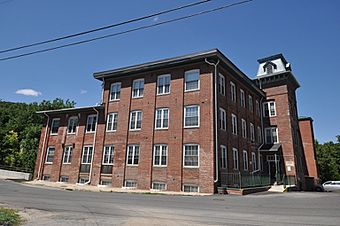Gilbert Clock Factory facts for kids
Quick facts for kids |
|
|
Gilbert Clock Factory
|
|
 |
|
| Location | Wallens St., Winchester, Connecticut |
|---|---|
| Area | 3.8 acres (1.5 ha) |
| Built | 1871 |
| Architectural style | Late 19th And Early 20th Century American Movements, Second Empire, Mansard;19th C. Industrial |
| NRHP reference No. | 84000494 |
| Added to NRHP | December 13, 1984 |
The Gilbert Clock Factory is a very old factory building in Winchester, Connecticut. It was built between 1871 and 1897. This factory is important because it shows how Connecticut was a big center for making clocks a long time ago.
The company was one of the biggest employers in the town for many years. Today, the old factory buildings have been turned into apartments where people live. These buildings were added to the National Register of Historic Places in 1984.
The Gilbert Clock Factory: A Look Back
The old Gilbert Clock Factory is in a neighborhood north of Winsted's main town area. It sits on the east side of the Still River, next to Wallens Street.
Long ago, the factory was much bigger. Some parts of it were destroyed by a fire in 1975. The two main buildings that are still standing are made of brick and have four stories. They show a popular building style from the late 1800s. One building is right by the river, and the other is a bit higher up the hill.
Building a Clock Empire
William L. Gilbert started his career in Bristol, Connecticut. This town was famous for making clocks. In 1840, he moved to Winchester. Here, he began making clocks that were not too expensive, like wall clocks and shelf clocks, for many people to buy.
Around 1870-1871, when his business was one of the largest clock makers in Connecticut, he built the first main building. The company kept growing. The factory complex on Wallens Street grew to have four large buildings. More than 500 people worked there! The company kept making clocks until 1964.
Keeping Things Safe: A Modern Check
Many years ago, a material called radium was sometimes used to make clock hands glow in the dark. Because of this, in 2016, a group called the Nuclear Regulatory Commission looked into the factory buildings. They wanted to make sure there was no risk from any old materials.
In 2018, experts visited the factory. They checked different spots in one of the buildings. They found a few places with very low levels of radiation, but there was no harmful dust or anything that could spread. Most importantly, they found no risk to public health. Because of this, the matter was closed, and no further action was needed. This means the buildings are safe for people today.



